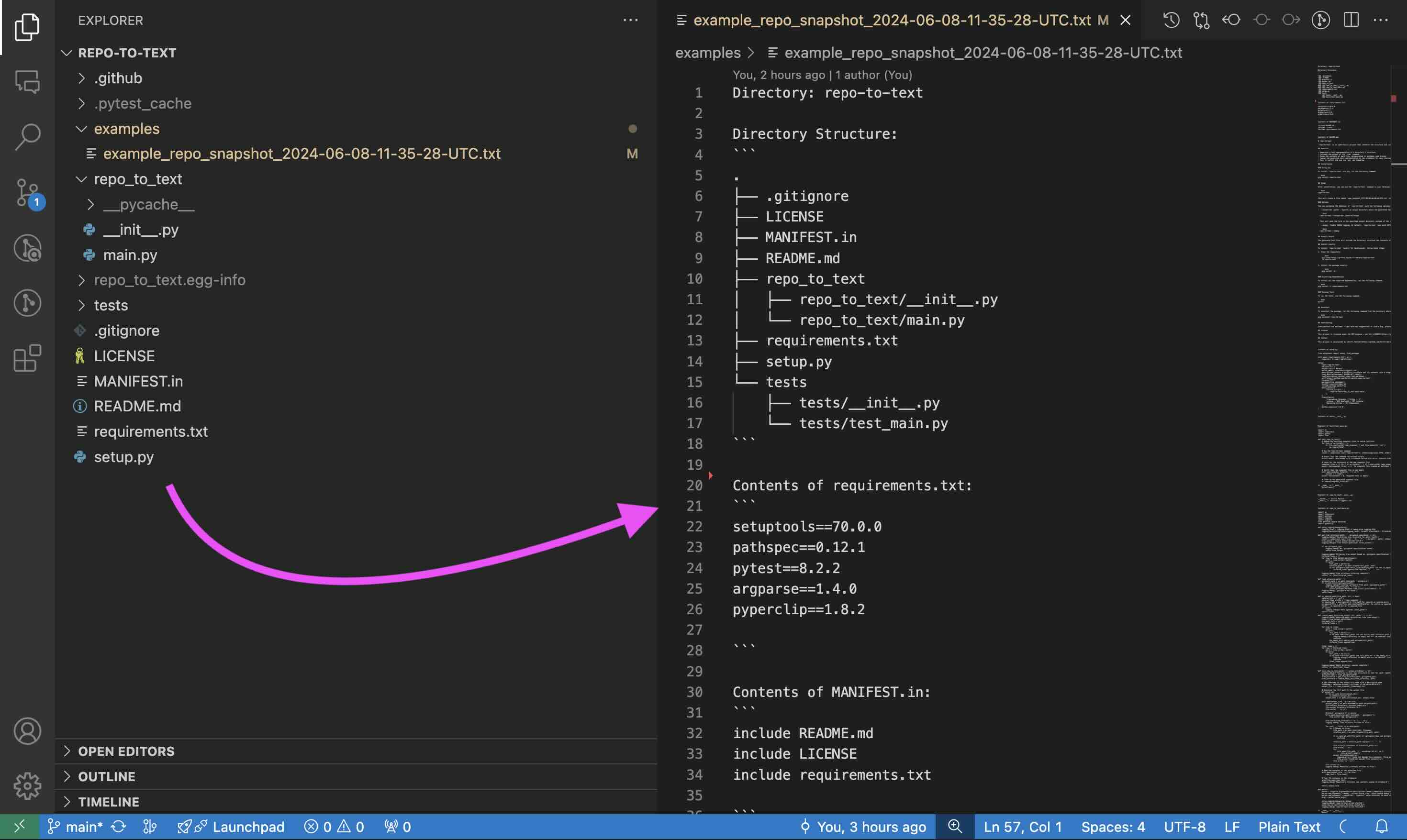repo-to-text converts a directory's structure and contents into a single text file. Run it from the terminal to generate a formatted text representation that includes the directory tree and file contents. This makes it easy to share code with LLMs for development and debugging.
pip install repo-to-text— install the packagecd <your-repo-dir>— navigate to the repository directoryrepo-to-text— run the command, result will be saved in the current directory
The generated text file will include the directory structure and contents of each file. For a full example, see the example output for this repository.
To install repo-to-text via pip, run the following command:
pip install repo-to-textTo upgrade to the latest version, use the following command:
pip install --upgrade repo-to-textAfter installation, you can use the repo-to-text command in your terminal. Navigate to the directory you want to convert and run:
repo-to-textor
flattenThis will create a file named repo-to-text_YYYY-MM-DD-HH-MM-SS-UTC.txt in the current directory with the text representation of the repository. The contents of this file will also be copied to your clipboard for easy sharing.
You can customize the behavior of repo-to-text with the following options:
-
--output-dir <path>: Specify an output directory where the generated text file will be saved. For example:repo-to-text --output-dir /path/to/output
This will save the file in the specified output directory instead of the current directory.
-
--create-settingsor--init: Create a default.repo-to-text-settings.yamlfile with predefined settings. This is useful if you want to start with a template settings file and customize it according to your needs. To create the default settings file, run the following command in your terminal:repo-to-text --create-settings
or
repo-to-text --init
This will create a file named
.repo-to-text-settings.yamlin the current directory. If the file already exists, an error will be raised to prevent overwriting. -
--debug: Enable DEBUG logging. By default,repo-to-textruns with INFO logging level. To enable DEBUG logging, use the--debugflag:repo-to-text --debug
or to save the debug log to a file:
repo-to-text --debug > debug_log.txt 2>&1
-
input_dir: Specify the directory to process. If not provided, the current directory (.) will be used. For example:repo-to-text /path/to/input_dir
-
--stdout: Output the generated text to stdout instead of a file. This is useful for piping the output to another command or saving it to a file using shell redirection. For example:repo-to-text --stdout > myfile.txtThis will write the output directly to
myfile.txtinstead of creating a timestamped file.
-
Build the container:
docker compose build
-
Start a shell session:
docker compose run --rm repo-to-text
Once in the shell, you can run repo-to-text:
-
Process current directory:
repo-to-text
-
Process specific directory:
repo-to-text /home/user/myproject
-
Use with options:
repo-to-text --output-dir /home/user/output
The container mounts your home directory at /home/user, allowing access to all your projects.
repo-to-text also supports configuration via a .repo-to-text-settings.yaml file. By default, the tool works without this file, but you can use it to customize what gets included in the final text file.
To create a settings file, add a file named .repo-to-text-settings.yaml at the root of your project with the following content:
# Syntax: gitignore rules
# Ignore files and directories for all sections from gitignore file
# Default: True
gitignore-import-and-ignore: True
# Ignore files and directories for tree
# and "Contents of ..." sections
ignore-tree-and-content:
- ".repo-to-text-settings.yaml"
- "examples/"
- "MANIFEST.in"
- "setup.py"
# Ignore files and directories for "Contents of ..." section
ignore-content:
- "README.md"
- "LICENSE"
- "tests/"You can copy this file from the existing example in the project and adjust it to your needs. This file allows you to specify rules for what should be ignored when creating the text representation of the repository.
- gitignore-import-and-ignore: Ignore files and directories specified in
.gitignorefor all sections. - ignore-tree-and-content: Ignore files and directories for the tree and "Contents of ..." sections.
- ignore-content: Ignore files and directories only for the "Contents of ..." section.
Using these settings, you can control which files and directories are included or excluded from the final text file.
Using Wildcard Patterns
*.ext: Matches any file ending with .ext in any directory.dir/*.ext: Matches files ending with .ext in the specified directory dir/.**/*.ext: Matches files ending with .ext in any subdirectory (recursive).
If you want to include certain files that would otherwise be ignored, use the ! pattern:
ignore-tree-and-content:
- "*.txt"
- "!README.txt"To ignore the generated text files, add the following lines to your .gitignore file:
repo-to-text_*.txtTo install repo-to-text locally for development, follow these steps:
-
Clone the repository:
git clone https://github.com/kirill-markin/repo-to-text cd repo-to-text -
Install the package with development dependencies:
pip install -e ".[dev]"
- Python >= 3.6
- Core dependencies:
- setuptools >= 70.0.0
- pathspec >= 0.12.1
- argparse >= 1.4.0
- PyYAML >= 6.0.1
For development, additional packages are required:
- pytest >= 8.2.2
- black
- mypy
- isort
- build
- twine
To run the tests, use the following command:
pytestTo uninstall the package, run the following command from the directory where the repository is located:
pip uninstall repo-to-textContributions are welcome! If you have any suggestions or find a bug, please open an issue or submit a pull request.
This project is licensed under the MIT License - see the LICENSE file for details.
This project is maintained by Kirill Markin. For any inquiries or feedback, please contact [email protected].
